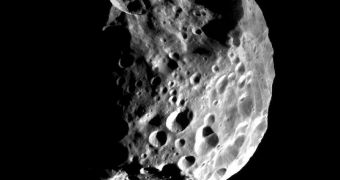New investigations of the Saturnine moon Phoebe indicate that the celestial body is in fact a planetesimal, a planetary embryo that may have grown to the size of Mars or Earth, early on in the history of the solar system.
The object is similar to Vesta, the largest asteroid in the solar system, which lies in the Inner Asteroid Belt (between the orbits of Mars and Jupiter). Cataloged as planetary embryos, these objects were stopped from growing beyond their current size by unusual events.
According to the conclusions of the new study, it would appear that Phoebe is both a planetesimal, and a former member of the Kuiper Belt, an asteroid belt beyond the orbit of Pluto. At some point in time, the object must have been ejected from the Belt, and sent in the inner solar system.
As it passed next to Saturn, the gas giant's huge gravitational pull captured the space rock, and set it in a stable orbit. Details of how this occurred were published in the latest issue of the journal Icarus. The investigation was carried out using the NASA Cassini orbiter.
Scientists also determined that Phoebe was spherical early on in its existence, while also displaying high temperatures at the surface. A rock-rich material concentrated at its core, making it resemble planets more than moons.
“Unlike primitive bodies such as comets, Phoebe appears to have actively evolved for a time before it stalled out,” NASA Jet Propulsion Laboratory (JPL) planetary scientist, Julie Castillo-Rogez, explains.
“Objects like Phoebe are thought to have condensed very quickly. Hence, they represent building blocks of planets. They give scientists clues about what conditions were like around the time of the birth of planets and their moons,” she goes on to say.
The JPL, managed by the California Institute of Technology (Caltech), in Pasadena, in turn manages the Cassini mission for the Science Mission Directorate, at NASA Headquarters, in Washington DC.
Cassini has been studying Saturn, its moons and its ring system since achieving orbital insertion around the gas giant, on July 1, 2004. Mostly, it focused its attention on the planet itself, and on the moons Enceladus and Titan. The new study suggests that Phoebe is also a good target for investigations.
“By combining Cassini data with modeling techniques previously applied to other solar system bodies, we've been able to go back in time and clarify why [Phoebe] is so different from the rest of the Saturn system,” Cornell University Cassini team member and study coauthor, Jonathan Lunine, explains.

 14 DAY TRIAL //
14 DAY TRIAL //